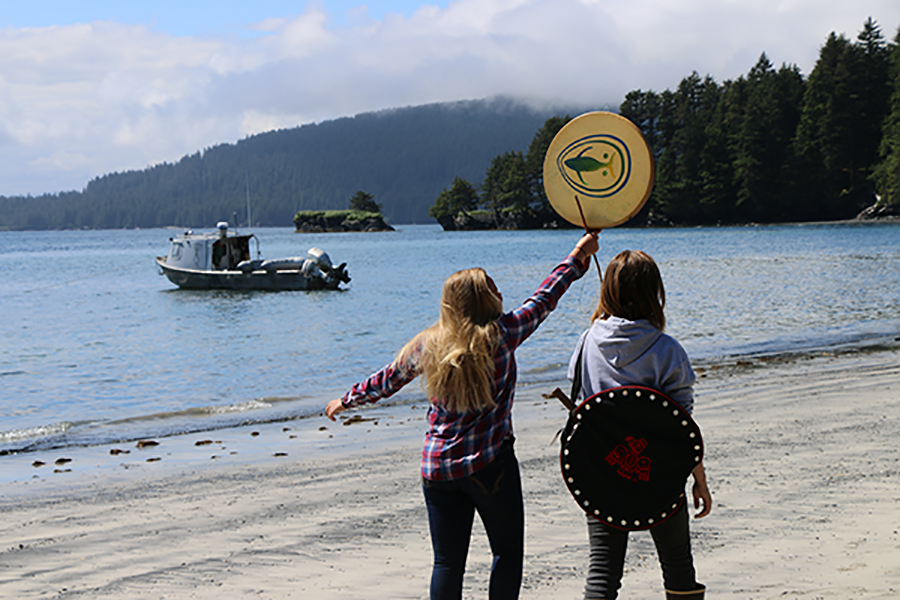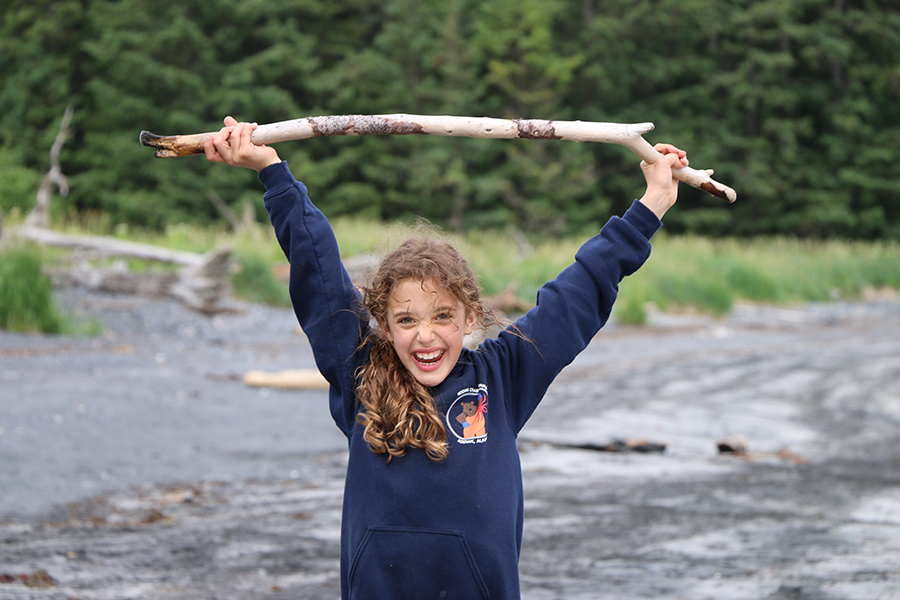As Alaska Native corporations celebrate the value of the Alaska Native Claims Settlement Act (ANCSA) in its first half century, Koniag will be sharing stories throughout the year highlighting ANCSA at 50 Successes.
Connection to ancestral lands and language, leading to personal and community pride in who we are and where we are from are at the heart of how Koniag sees the Alaska Native Claims Settlement Act (ANCSA) today. When President Nixon signed the bill into law on December 18, 1971, creating a different kind of corporation and a new kind of shareholder, few could have predicted just how successful the new corporations would become, producing positive impacts far beyond just dollars and jobs.
In the Koniag region, two examples of this far-ranging success are the Alutiiq Museum and Dig Afognak. Ask anyone who’s been to Dig Afognak, and you’ll receive a multitude of responses about its powerful, moving impact.
“When you are at Dig Afognak your mind and spirit expand. You breathe deeper and slow down. It helps you understand where you belong and fit in,” describes Malia Villegas. Malia lives in Seattle now, working for Afognak Native Corporation, but her experiences at Dig Afognak are never far from her mind.
“Being there brought a sense of pride at the brilliance of my ancestors,” says Pat (Juney) Mullan, who spent many summers working at the camp. “They were able to design and make arrowheads, toggling harpoons, halibut hooks out of just beach wood and rocks, and survive. They never went to school; they created those things with a creative imagination and mind.”
Dig Afognak originated around two decades ago, when Afognak Native Corporation donated the land that was previously used as an archaeological dig site to the Native Village of Afognak. Storm waves, vandalism, and time itself were working to destroy the archaeological record at the dig site, and Kodiak Island’s Alutiiq communities wanted to assure that the record was preserved and shared as a crucial way to sustain their heritage for all generations.
Today, Dig Afognak goes well beyond archaeology. Over the past two decades, it has grown to a year-round operation with several different programs and camps throughout the summer. Some focus on Alutiiq language and music, others on subsistence living—including everything from fishing, hunting, foraging, and preserving the harvest—and some on personal strength building and leadership. All told, it hosts a dozen weeks of summer camps for Alutiiq youth and even adults. The camp is operated by the Native Village of Afognak and funded by contributors like Koniag, Afognak Native Corporation, and Ouzinkie Native Corporation.
Nina Gronn, a Koniag Shareholder who now works for Koniag, was involved with Dig Afognak for nine years. “It’s awesome,” she says. “It provides a sense of place, of where we as a people are from. Even before you step on Afognak, being able to see it from the skiff is like going into a different dimension. The problems of the modern world go away, and it feels like I am home.”
Villegas agrees. “First and foremost, being there centers you to place,” she says.
Gronn, Mullan, and Villegas have all spent significant time at the camp seeing how it helps young people find confidence. Gronn says, “Being connected to the land and the Alutiiq culture can be a big part of healing from trauma.” The camp helps people “find their identity through their culture,” she adds, showing them they have a history and a home.
“I think it teaches the kids how to be a comfortable part of a group, and it brings a sense of belonging,” reflects Mullan. “They were able to be silly, giggle, and just be. It was like they finally found a connection to a culture, an understanding of where their ancestors came from.” He recalls that taking the campers over to the original Afognak village site, where he grew up, was equally meaningful to both he and the kids who were often seeing their great- and great-great-grandparents’ houses for the first time.
Villegas puts the impact this way: “When you go home, to Dig Afognak, you’re just one piece in a puzzle–you bring forward the next generation. You’re not alone. You feel the past and future generations with you. Here, you can find…your particular gift, the thing you were born for.”
Much of the Alutiiq people’s vivid history on the archipelago is now cared for by the Alutiiq Museum in Kodiak, including many artifacts found at the former archaeology site at Dig Afognak. The world class institution – one of only two nationally accredited Indigenous museums in the country – just celebrated its 25th anniversary.
The Alutiiq Museum was founded in 1995 with financial support from the Exxon Valdez Oil Spill fund, with a mission of celebrating heritage through living culture. Since its inception, the museum has been supported by donations from Koniag, KANA and all in-region village corporations. Enlivening the past for Alutiiq people and Kodiak Island communities is at the forefront of the museum’s work, and the facility takes a very different approach than keeping its collection locked within a glass case.
“Our people will never learn about our history unless they have access to it,” says Alutiiq Museum Executive Director Dr. April Counceller. “Everything we do is centered around ‘how can we get this into the community? How can we get this in front of people?”
“A museum is a tool for us to take back our rich cultural history, not only to share it, but to pass it to the next generation,” adds Koniag Board Member Dr. Sven Haakanson, Jr.
From its early years, the museum prioritized working collaboratively with the island’s villages and artisans to hold Culture Weeks for school-age kids. The museum utilized its collections and worked with an artisan to teach kids how to create various projects like basket weaving, qayaq model making, and mask carving. Before the pandemic, the museum was a frequent stop for school trips coming from Kodiak Island villages. Museum staff has always prioritized finding ways for people living off the island to connect to their culture, including online virtual exhibits. Given the current virtual environment, the museum has taken these efforts to a new level, creating kits that include videos, downloadable instructions, and project materials.
“We have Alutiiq people living across the country, Koniag Shareholders and Descendants who are amazed that they can go on our website, download something, start doing a traditional craft and feel closer to their culture by doing so,” says Counceller.
Both Haakanson, Jr. and Counceller emphasize the museum’s role in bringing Alutiiq cultural knowledge to a new level of awareness and celebration.
“Since European contact, our traditional knowledge has been systematically suppressed. The museum is representing our ability to take this knowledge back,” states Haakanson, Jr. “For me, it’s meaningful to see the museum becoming a central place where our people can have our knowledge and learn from it.”
“We know—and there are studies that have indicated—that young people who have access to their culture and their language have higher rates of graduating high school, lower rates of high-risk behaviors. Because when you feel like you belong to something, it strengthens you as an individual,” says Counceller. She believes that part of the museum’s work is to “make young people feel more confident as Native people.”
“When I was growing up in the village, we sang cowboy songs. They didn’t have access or know what to teach us about our culture. Nowadays, the kids in our school are learning Alutiiq, place-based education, and they can incorporate culture not just into art class but also into math and science,” adds Counceller. “It’s really changed the way kids grow up on the island, not just Native kids, but all kids.”
This opportunity to learn from and about the past strengthens Alutiiq culture today and is one illustration of the success of the Alaska Native Claims Settlement Act. One of the unique aspects about Alaska Native corporations (ANCs) created through ANCSA is their focus on cultural preservation.
“There is a sense of responsibility that ANCs have to the communities that their shareholders and descendants are living in,” says Counceller. At Koniag, this manifests in dedicated support for long-term cultural programs like Dig Afognak and the Alutiiq Museum.
“That’s the wonderful thing about Koniag – we are a corporation of all the people, and through our support it belongs to all of us,” says Haakanson, Jr.
Dig Afognak and the Alutiiq Museum demonstrate how the Alaska Native Claims Settlement Act has assisted cultural revitalization in the Koniag region and across the state. They are just two of the hundreds of ANC-sponsored culture programs and organizations that empower Alaska Native people to feel connected to their past heritage, invested in their current success, and confident in a stronger tomorrow.




